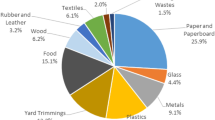Abstract
A novel process configuration for sorption-enhanced methanation (SEM) based on the technology of dual interconnected fluidized beds was recently proposed. The idea consists of a chemical looping system where in one reactor (the methanator), catalytic methanation occurs simultaneously with H2O capture by a suitable sorbent to drive the equilibrium towards methane formation, while in another reactor (dehydrator), the regeneration of the sorbent takes place. In this work, two possible H2O sorbents for such a SEM process were tested under simulated SEM conditions. The sorbents were a granular CaO obtained from natural limestone, which reacts with H2O to form Ca (OH)2, and an attrition-resistant spherical 3A-zeolite, which physically adsorbs H2O. Each test consisted of 10 complete hydration/dehydration cycles in a lab-scale twin fluidized bed device. The temperature range investigated for hydration was 200–300 °C, while that for dehydration was 350–450 °C. CaO showed a decay of the steam capture capacity with the number of cycles, induced by the irreversible carbonation of the sorbent with CO2. By contrast, the zeolite had a more stable behavior in all conditions. The presence of a high CO2 concentration reduced the steam capture capacity of both sorbents, but this effect was more evident for CaO, because of the abovementioned carbonation reaction. For the zeolite, results suggest that CO2 competes with H2O for adsorption in the sorbent. In-bed particle fragmentation was limited for CaO and absent for the zeolite. On the whole, results indicate that both sorbents can be used for the SEM process. The zeolite shows a better asymptotic capture capacity than CaO and it is not affected by deactivation during the cycles, though it is a more expensive material.










Similar content being viewed by others
Data availability
Available upon request.
References
Seifert AH, Rittmann S, Herwig C (2014) Analysis of process related factors to increase volumetric productivity and quality of biomethane with Methanothermobacter marburgensis. Appl Energy 132:155–162
Götz M, Lefebvre J, Mörs F, McDaniel Koch A, Graf F, Bajohr S, Reimert R, Kolb T (2016) Renewable power-to-gas: a technological and economic review. Renew Energy 85:1371–1390
Rönsch S, Schneider J, Matthischke S, Schlüter M, Götz M, Lefebvre J, Prabhakaran P, Bajohr S (2016) Review on methanation - from fundamentals to current projects. Fuel. 166:276–296
Sabatier P, Senderens JB (1902) New methane synthesis. Compte Rendu Acad Sci Paris 134:514–516
Smestad GP, Steinfeld A (2012) Review: photochemical and thermochemical production of solar fuels from H2O and CO2 using metal oxide catalysts. Ind Eng Chem Res 51:11828–11840
Cuéllar-Franca RM, Azapagic A (2015) Carbon capture, storage and utilisation technologies: a critical analysis and comparison of their life cycle environmental impacts. J CO2 Util 9:82–102
Pleßmann G, Erdmann M, Hlusiak M, Breyer C (2014) Global energy storage demand for a 100% renewable electricity supply. Energy Procedia 46:22–31
de Boer HS, Grond L, Moll H, Benders R (2014) The application of power-to-gas, pumped hydro storage and compressed air energy storage in an electricity system at different wind power penetration levels. Energy. 72:360–370
Sabatier P, Senderens JB (1902) Direct hydrogenation of oxides of carbon in presence of various finely divided metals. CR Acad Sci 134:689–691
Mills GA, Steffgen FW (1974) Catalytic methanation. Catal Rev 8:159–210
Panagiotopoulou P, Kondarides DI, Verykios XE (2009) Selective methanation of CO over supported Ru catalysts. Appl Catal B Environ 88:470–478
M. V Twigg, Catalyst handbook, Routledge, 2018.
Bartholomew CH (2001) Mechanism of catalyst deactivation.pdf. Appl Catal A Gen 212:17–60
M. Seemann, Methanation of biosyngas in a fluidized bed reactor: development of a one-step synthesis process, featuring simultaneous methanation, watergas shift and low temperature tar reforming, PhD Thesis, ETH Zurich, Switzerland (2007).
Borgschulte A, Gallandat N, Probst B, Suter R, Callini E, Ferri D, Arroyo Y, Erni R, Geerlings H, Züttel A (2013) Sorption enhanced CO2 methanation. Phys Chem Chem Phys 15:9620–9625
Walspurger S, Elzinga GD, Dijkstra JW, Sarić M, Haije WG (2014) Sorption enhanced methanation for substitute natural gas production: Experimental results and thermodynamic considerations. Chem Eng J 242:379–386
Massa F, Coppola A, Scala F (2020) A thermodynamic study of sorption-enhanced CO2 methanation at low pressure. J CO2 Utiliz 35:176–184
Coppola A, Massa F, Salatino P, Scala F (2019) Fluidized bed CaO hydration-dehydration cycles for application to sorption-enhanced methanation. Combust Sci Technol 191:1724–1733
Coppola A, Scala F, Gargiulo L, Salatino P (2017) A twin-bed test reactor for characterization of calcium looping sorbents. Powder Technol 316:585–591
Coppola A, Palladino L, Montagnaro F, Scala F, Salatino P (2015) Reactivation by steam hydration of sorbents for fluidized-bed calcium looping. Energy Fuel 29:4436–4446
Scala F, Cammarota A, Chirone R, Salatino P (1997) Comminution of limestone during batch fluidized-bed calcination and sulfation. AICHE J 43:363–373
Acknowledgments
C. De Giacomo, A. Esposito, A. Pace, A. Russo, L. Tregrossi, and N. Vallefuoco are gratefully acknowledged for their relevant contribution in carrying out the experimental tests.
Code availability
Not applicable.
Author information
Authors and Affiliations
Contributions
All authors contributed to the study. Material preparation, data collection, and analysis were performed by Antonio Coppola and Fiorella Massa. The first draft of the manuscript was written by Fabrizio Scala and all authors commented on previous versions of the manuscript. All authors read and approved the final manuscript.
Corresponding author
Ethics declarations
Conflict of interest
The authors declare that they have no conflict of interest.
Additional information
Publisher’s Note
Springer Nature remains neutral with regard to jurisdictional claims in published maps and institutional affiliations.
Rights and permissions
About this article
Cite this article
Coppola, A., Massa, F., Salatino, P. et al. Evaluation of two sorbents for the sorption-enhanced methanation in a dual fluidized bed system. Biomass Conv. Bioref. 11, 111–119 (2021). https://doi.org/10.1007/s13399-020-00829-4
Received:
Revised:
Accepted:
Published:
Issue Date:
DOI: https://doi.org/10.1007/s13399-020-00829-4




